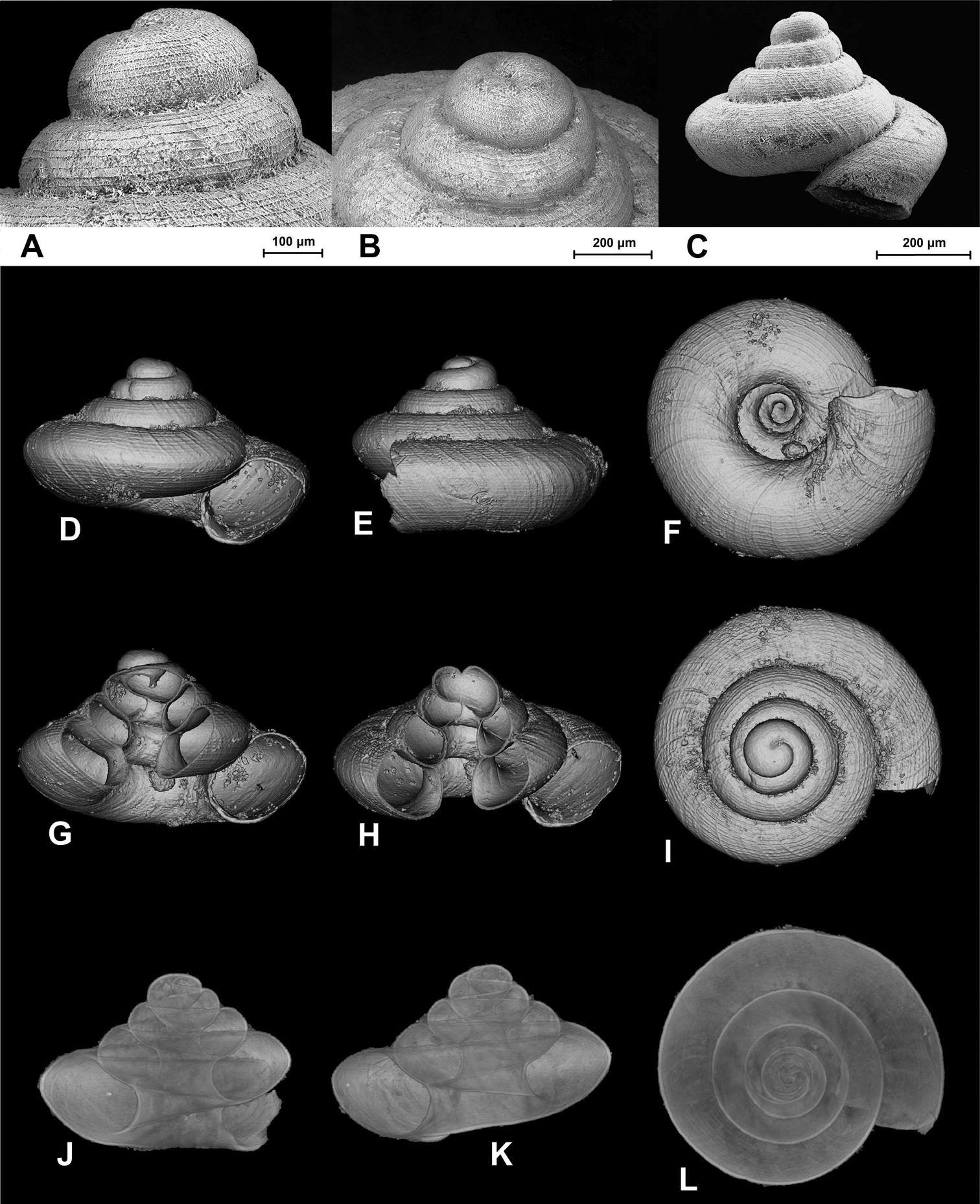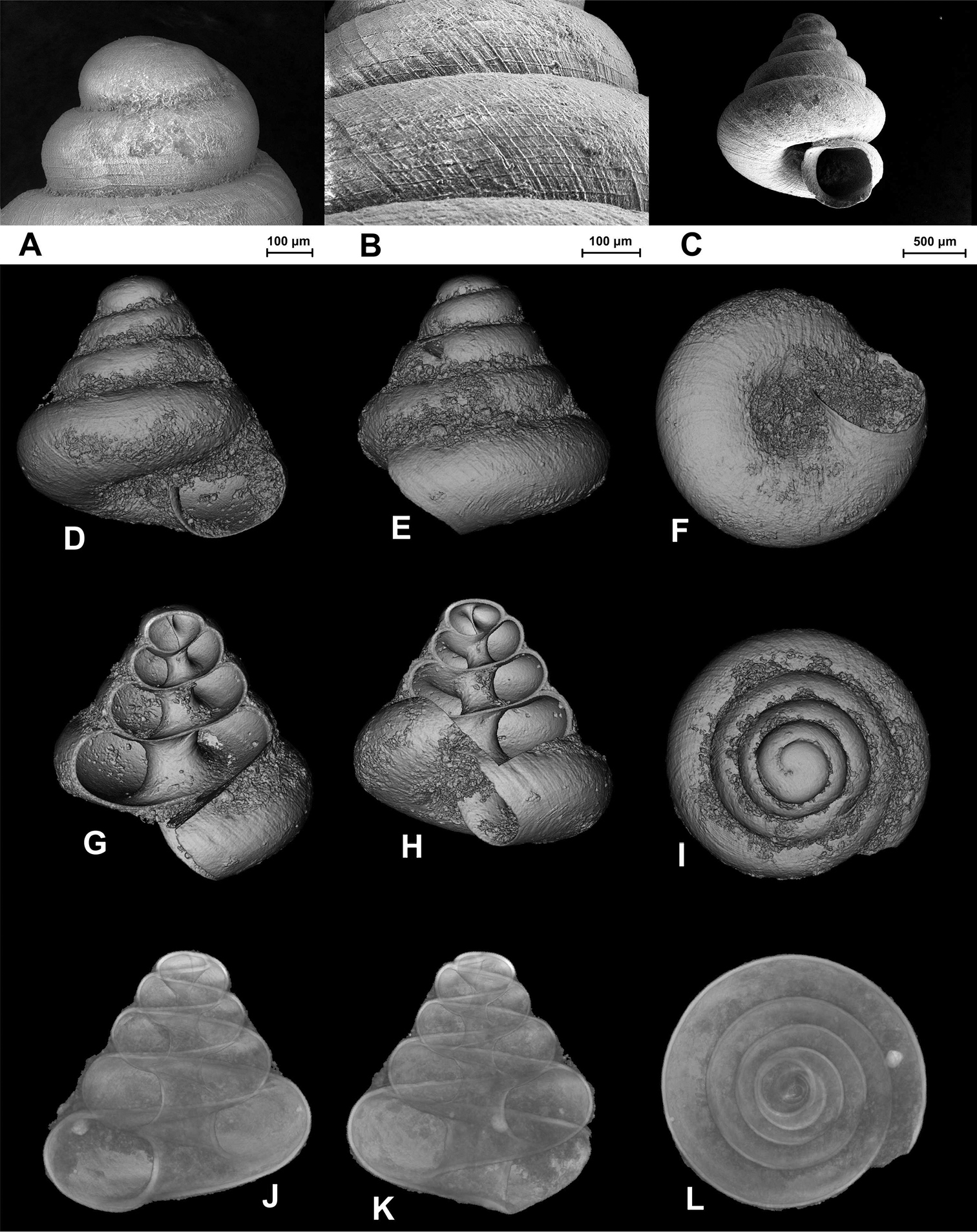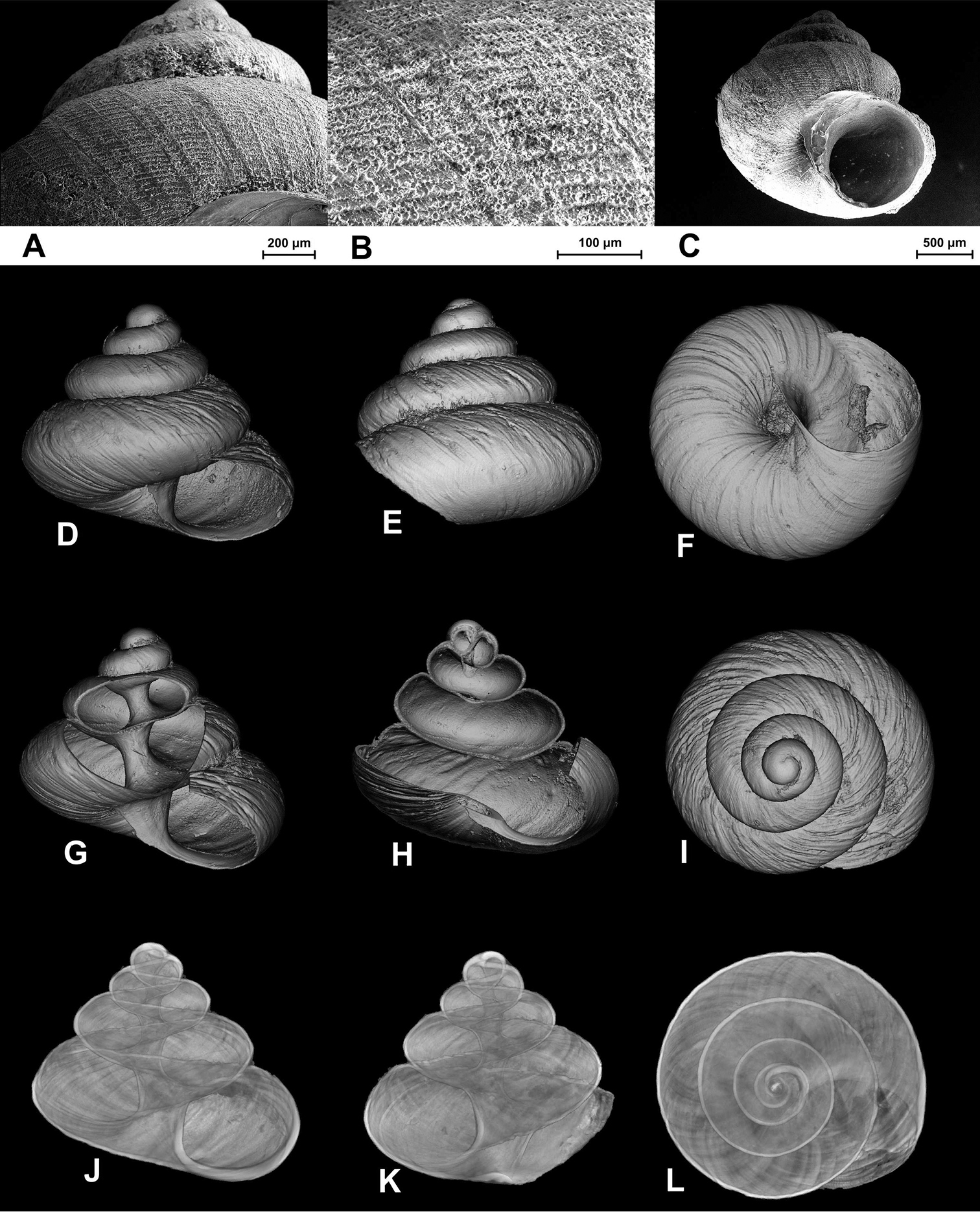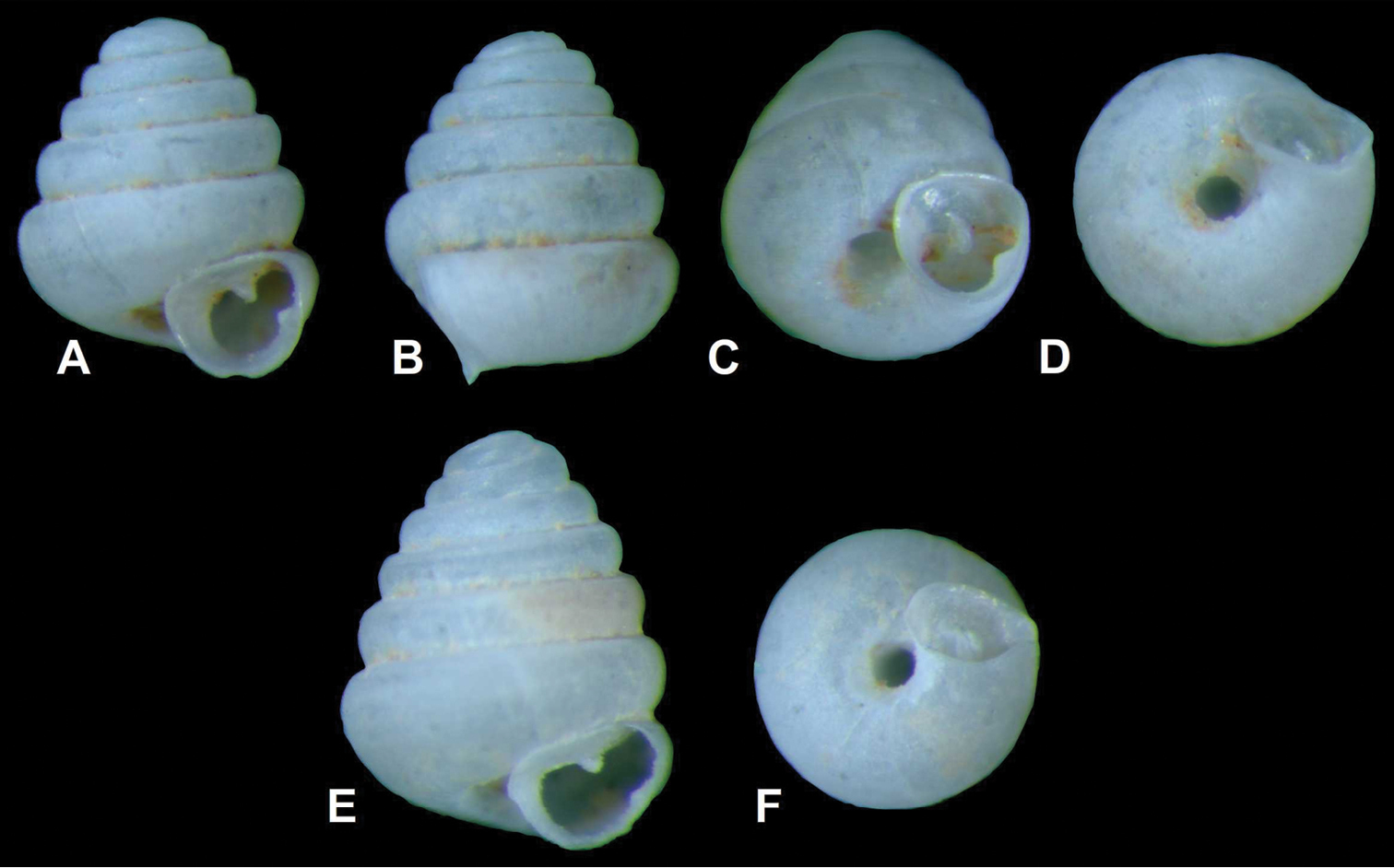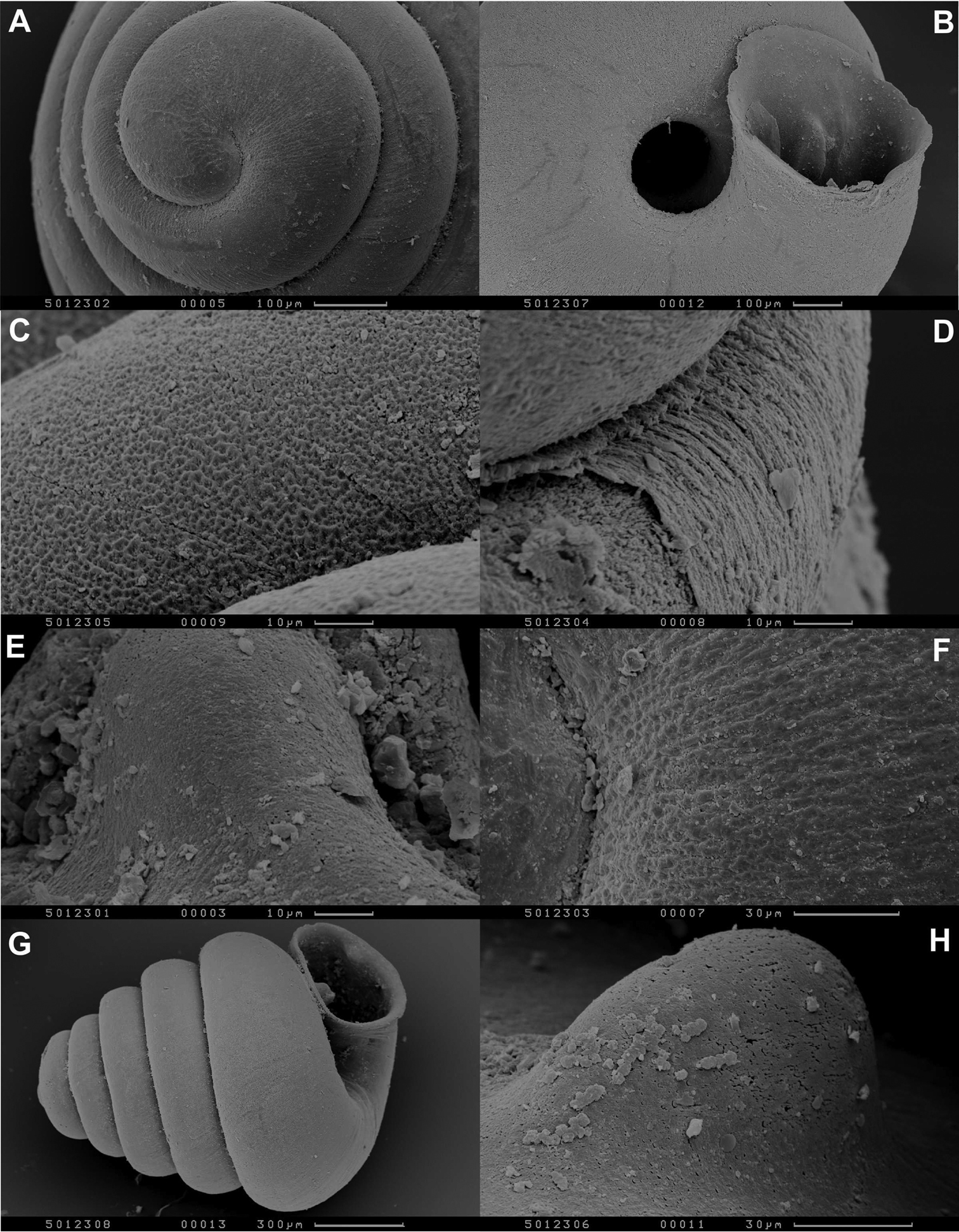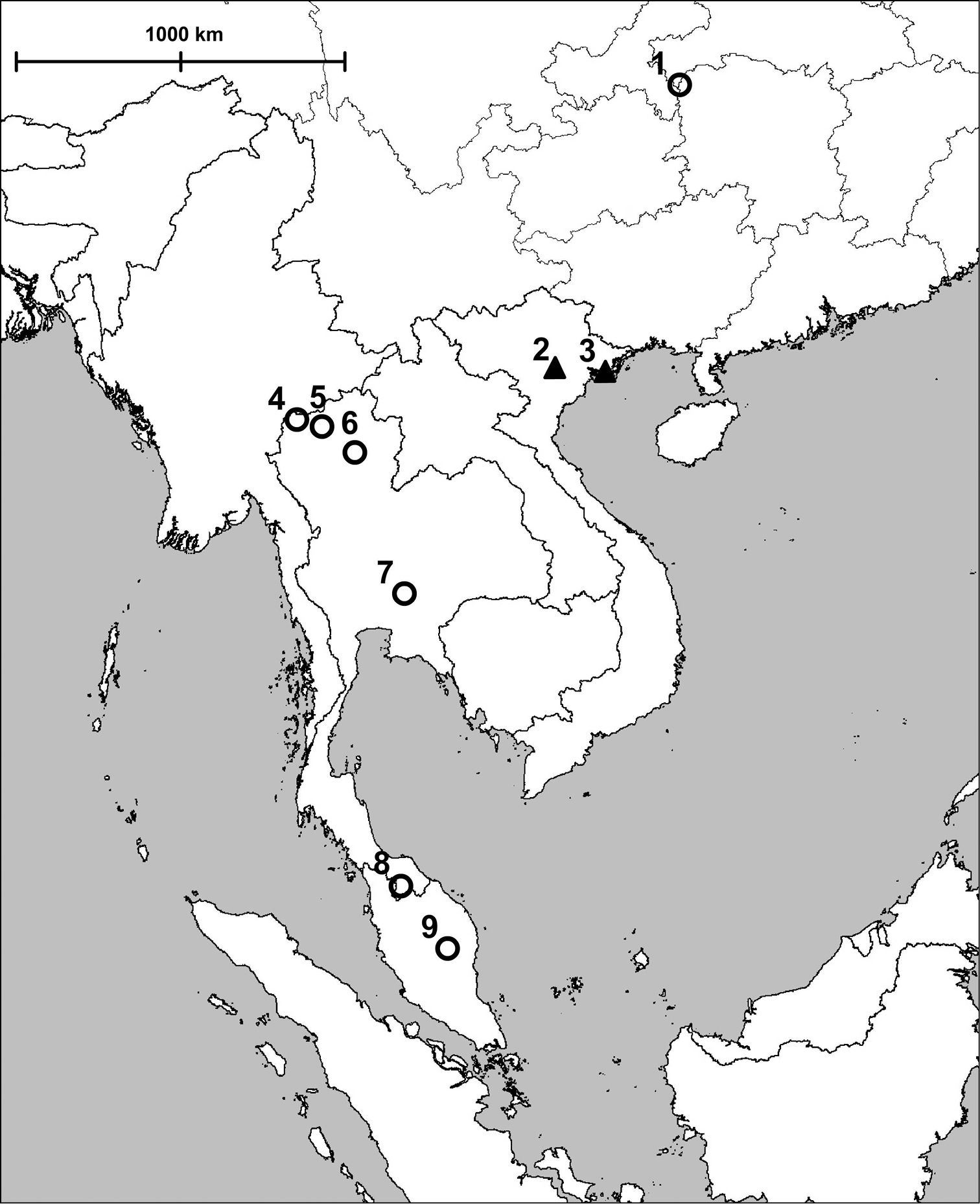






Citation: Jochum A, Slapnik R, Kampschulte M, Martels G, Heneka M, Páll-Gergely B (2014) A review of the microgastropod genus Systenostoma Bavay & Dautzenberg, 1908 and a new subterranean species from China (Gastropoda, Pulmonata, Hypselostomatidae). ZooKeys 410: 23–40. doi: 10.3897/zookeys.410.7488
A review of the microgastropod genus Systenostoma is provided. Thai and Malaysian species are transferred to a new genus, Angustopila (type species: Systenostoma tamlod Panha & Burch, 1999). A new subterranean Angustopila species is described here. Conchologically, the new species is most similar to the cave-dwelling, Thai A. tamlod (Panha & Burch, 1999). One Thai species (Systenostoma edentata) is transferred to the genus Hypselostoma. Vietnamese members remain in the genus Tonkinospira (nomen novum) for Systenostoma Bavay & Dautzenberg, 1908 (non Systenostoma Marsson, 1887). A comprehensive map of former Systenostoma species is presented. SEM and NanoCT images, including a video of A. huoyani sp. n. internal shell morphology, provide novel perspectives of the shells of Angustopila and of the scarcely known Vietnamese Tonkinospira species. The biology of these snails is not yet known but collection localities suggest a troglophilic ecology.
Taxonomy, subterranean snail, Pupillidae, Vertiginidae, conservation, cave-dwelling species
Microgastropods are less than 5 mm in size and represent the majority of worldwide tropical land snail diversity. They are restricted to specific microhabitats such as limestone rock surfaces or caves, have limited active dispersal ability and thus, frequently demonstrate high local endemism. Due to their small size and high degree of endemicity, our knowledge of the taxonomy and ecology of microgastropod taxa such as the hypselstomatid genus Systenostoma is limited. Consequently, very little is known about tiny species and thus, the complex systematics of most tropical microgastropod groups is based on conchological characters only.
The microgastropod genus Systenostoma was established as a subgenus of Helix by
The classification of Systenostoma is problematic. Together with the suspected, closely related genera (e.g. Acinolaemus Thompson & Upatham, 1997, Anauchen Pilsbry, 1917, Boysidia Ancey, 1881, Hypselostoma Benson, 1856, Krobylos Panha & Burch, 1999, Gyliotrachela Tomlin, 1930), Systenostoma is sometimes classified within Pupillidae (e. g.
All Systenostoma have a relatively simple shell compared to the other members of the family Hypselostomatidae, whose shells usually have oddly coiled shapes and multiple apertural denticles. Still, Systenostoma species show a high diversity in general shell shape, aperture shape and dentition and shell sculpture. Systenostoma seems to represent a “collection bin” taxon for species possessing few or no denticles. The reduction of the apertural teeth however, could have evolved independently in different evolutionary lineages. In this case, congeners may well have been classified/lumped within one genus but systematically belong to at least three genera. In the following, we describe a new, subterranean species from China, present an overview of all former Systenostoma species, describe a new genus for Thai, Malaysian and the new Chinese species, transfer Systenostoma edentata to the genus Hypselostoma and assign a new name (Tonkinospira) to the Vietnamese species because the name Systenostoma (non Systenostoma
RBINS Royal Belgian Institute of Natural Sciences (Brussels, Belgium)
SMF Senckenberg Forschungsinstitut und Naturmuseum (Frankfurt am Main, Germany)
MCSMNH Malacological collection of the Slovenian Museum of Natural History (Ljubljana, Slovenia)
SMNS Staatliches Museum für Naturkunde Stuttgart (Stuttgart, Germany)
SEM: One paratype of Angustopila huoyani sp. n. was mounted on an aluminium stub, gold-palladium sputtered using the Edwards Kniese Sputter Coater S150B (Marburg, Germany) and subsequently scanned on the CamScan CS 24 scanning electron microscope (Dortmund, Germany). Specimens of Tonkinospira nom. n. were non-coated and imaged with the Zeiss EVO LS15 scanning electron microscope (Jena, Germany) using the Variable Pressure (VP) mode.
Micro-CT: Tonkinospira nom. n. species were imaged using a nano-computed tomography system (nano-CT), manufactured and developed by Bruker-Micro-CT/SkyScan (SkyScan 2011, Kontich, Belgium) at the Department of Experimental Radiology, Justus-Liebig University Biomedical Research Center Seltersberg (BFS), Giessen, Germany. The scanner is based on a nanofocus tube generating X-rays in cone-beam geometry. Briefly, the system contains an open pumped type X-ray source, a LaB6 cathode and a transmission anode consisting of a tungsten-coated beryllium window. Enhanced edge sharpness is gained by a high-focussed X-ray spot of 300 nm side length (see
Digital images: Angustopila huoyani sp. n. was photographed using a Kontron-Electronik-ProgRes-3012 microscope camera (Jena, Germany) and a Leitz MZ12 stereomicroscope.
Systenostoma tamlod Panha & Burch, 1999.
Angustopila gen. n. is characterized by a very small, smooth, conical shell with regular, moderately increasing whorls. The body whorl sometimes extends beyond the penultimate whorl in profile. The sculpture of the protoconch is usually ornamented by spiral and radial lines resulting in a powdery, reticulated surface. The protoconch is slightly recessed into the second whorl. Aperture slightly or not adnate, with usually one or two denticles, peristome slightly reflexed.
The name derives from the combination of the Latin angustus (= narrow) and pila (= pillar, column). Gender: feminine.
Angustopila gen. n. differs from Tonkinospira nom. n. (former Vietnamese Systenostoma) by smaller shell size, more elevated spire, slightly reflexed apertural rim and general dentition present within the aperture. Acinolaemus usually has more teeth and a turban-like shell. Krobylos species have angulated whorls, lack spiral lines on the shell and possess a relatively large, toothless, adnate aperture.
The genus is known from Thailand and Malaysia. The Chinese Angustopila huoyani sp n. is located very distant, almost 1500 km from the northern Thai localities.
Systenostoma concava Thompson & Upatham, 1997: Bulletin of the Florida Museum of Natural History, 39 (7): 231–232, Fig. 32–38. [“Thailand, Nakhon Ratchasima Province, limestone hill 3.4 km west of Ban Mu Si, 380 m altitude (14°32.0'N, 101°22.5'E)”]
Systenostoma concava –
Systenostoma elevata Thompson & Upatham, 1997: Bulletin of the Florida Museum of Natural History, 39 (7): 232–233, Fig. 39–43. [“Thailand, Chiang Mae Province, Doi Chiang Dao (Mountain), 7 km west of Chiang Dao; 600 m altitude (19°24.3'N, 98°54.2'E)”]
Systenostoma elevata –
http://zoobank.org/2101F700-9723-422F-B70B-F8D0C2D20345
http://species-id.net/wiki/Angustopila_huoyani
Figure 4–5, Video 1China, Hunan, Longshan (龙山县), Huoyan (火焰), Feihu Dong (飞虎洞), (29°12.53'N, 109°18.37'E, 550 m alt.), soil, leg. Verovnik, 13.04.1997, MCSMNH 50312/1 (holotype), MCSMNH 50312/2–9 (8 paratypes).
A tiny, thin-shelled conical snail with very deep and narrow umbilicus, 5 shouldered whorls and two apertural denticles (parietal and palatal).
Shell thin, greyish white, semi opaque; conical, widest at its base, with a homogeneous powdery superficial texture and regularly increasing, shouldered whorls separated by deep suture; smooth with no notable spiral or radial sculpture. It is characterized by very fine irregular axial lamellae and reticulating microgranules producing the powdery superficial texture; protoconch shows reticulating granules and recognisable radial lines only at the upper part of the first whorl; aperture semi-circular, slightly oblique from ventral view; peristome very slightly thickened and reflexed; parietal callus adnate (attached to the penultimate whorl); aperture with two well-developed but short denticles, one on the parietal and the other on the palatal side; umbilicus very deep and narrow.
Micro-CT Video of Angustopila huoyani sp. n. Video: Markus Heneka. http://www.pensoft.net/J_FILES/video/Jochum_Video_1.avi
See Table 1.
Shell measurements (mm) for Angustopila huoyani sp. n. from the type locality. SH - shell height, SW - shell width, AH - aperture height, AW - aperture width, SW/SH×100 - shell width shared with shell height and multiplied 100, AW/AH×100 – aperture width shared with aperture height and multiplied 100).
| SH | SW | AH | AW | SW/SH×100 | AW/AH×100 | specimen |
|---|---|---|---|---|---|---|
| 1.09 | 0.87 | 0.33 | 0.43 | 80 | 133.33 | Holotype |
| 1.13 | 0.91 | 0.41 | 0.43 | 80.77 | 105.26 | Paratype |
| 1.09 | 0.89 | 0.35 | 0.41 | 82 | 118.75 | Paratype |
| 1.13 | 0.91 | 0.39 | 0.41 | 80.77 | 105.55 | Paratype |
| 1.20 | 0.96 | 0.43 | 0.43 | 80 | 100 | Paratype |
| 1.22 | 41641 | 0.39 | 0.46 | 83.93 | 116.66 | Paratype |
| 1.09 | 0.89 | 0.35 | 0.39 | 82 | 112.5 | Paratype |
| 1.09 | 0.91 | 0.33 | 0.39 | 84 | 120 | Paratype |
| 1.30 | 0.89 | 0.39 | 0.37 | 68.33 | 94.44 | Paratype |
Average. minimum value (min). maximum value (max). variance of values (var) and standard deviation of a set of values (stdev) for Angustopila huoyani sp. n. N = 30.
| SH | SW | AH | AW | SW/SH×100 | AW/AH×100 | |
|---|---|---|---|---|---|---|
| Average | 1.17 | 0.94 | 0.37 | 0.43 | 80.09 | 114.20 |
| Min | 1.04 | 0.85 | 0.33 | 0.37 | 68.33 | 94.44 |
| Max | 1.30 | 1.04 | 0.43 | 0.46 | 87.50 | 133.33 |
| Var | 0.0058 | 0.0031 | 0.0008 | 0.0007 | 15.4080 | 79.0895 |
| stdev | 0.0765 | 0.0560 | 0.0288 | 0.0288 | 3.9253 | 8.8932 |
Tonkinospira defixa, Tonkinospira pulverea, Tonkinospira pauperrima and Tonkinospira depressa are much larger than the new species, have reticulated sculpture and lack denticles in the aperture. Moreover, Tonkinospira defixa has a more depressed spire, fewer whorls, wider umbilicus and slightly keeled body whorl; Tonkinospira pulverea has fewer whorls, a comparatively larger aperture, somewhat keeled, wider body whorl and its umbilicus is partly closed by the apertural margin; Tonkinospira pauperrima shows increased bulging in whorl configuration; Tonkinospira depressa has a lower spire, slightly keeled body whorl and a large aperture without denticles. Hypselostoma (?) edentata also lacks denticles in the aperture and possesses a very wide, laterally compressed body whorl. Angustopila tamlod, the most similar species, is slightly smaller, has fewer whorls, wider umbilicus and obvious spiral striation on the teleoconch. Angustopila concava has a much wider body whorl than that of Angustopila huoyani, has weaker apertural denticles and prominent spiral sculpture. Angustopila elevata has no denticles in the aperture and possesses a wider umbilicus and spirally striated shell. Angustopila neglecta (see also notes under that species) has a wider umbilicus and more rapidly growing whorls, resulting in a comparatively wider body whorl than in the new species. Angustopila neglecta also has spiral lines on the shell and its sinulus is wider. Shell characters and ecological information of all Angustopila species are presented in Table 3.
The most important morphological traits and ecological information for Angustopila huoyani sp. n. and its congeners extracted from the literature.
| Angustopila concava | Angustopila elevata | Angustopila huoyani sp. n. | Angustopila neglecta | Angustopila tamlod | |
|---|---|---|---|---|---|
| Shell colour | greyish white | light gray | greyish white | white | white |
| Teleoconch sculpture | spiral threads; weak growth wrinkles | spiral threads; weak growth wrinkles | very fine irregular axial lamellae, reticulating microgranules | spiral threads; growth wrinkles | spiral threads |
| Protoconch sculpture | spiral/ reticulated | reticulating granules | reticulating granules | not described | not decribed |
| Aperture shape/ peristome | kidney-shaped, oblique | ovate, oblique | semi-circular, oblique | ovate | semi-circular |
| Aperture dentition | angular, upper palatal, parietal | dentition lacking | parietal, palatal | angular, upper palatal, weak basal | parietal, palatal |
| Umbilicus | narrow | narrow | very narrow | relatively wide | very narrow |
| Whorl number | 4.6–5.3 | 4.2–4.3 | 5.3 | 4.5 | 4.75 |
| Shell height (mm) | 1.02–1.21 | 0.92–0.99 | 1.04–1.3 | 1.2–1.8 | 0.9–1.0 |
| Ecology | leaf litter & limestone talus | leaf litter & limestone talus | cave | cave (?) | cave |
The new species is named after the Gorges of Huoyan, where the type locality is located.
The new species is known from the type locality only.
The new species is known only from the Feihu Dong (“Cave of the Wind Tiger”). Angustopila huoyani were culled from samples of rocky-loamy substrate collected in the entrance corridor of the cave. It is highly likely that the distribution of Angustopila huoyani sp. n. is restricted to this cave only.
Our knowledge of the biogeography of the genus is very limited. However, we assume that most Angustopila, especially the cave-dwelling species, are narrow-range endemics. Since extreme endemism always makes species vulnerable to human encroachment, this species warrants conservation priority. Currently, no direct threats are known.
Although the specimen on
Systenostoma tamlod Panha & Burch, 1999: Walkerana 10 (24): 118–121, Fig. 3. [“Lod Cave, Pang Ma Pa District, Mae Hong Son Province, 19°29'36"N, 98°17'18"E and 10°34'03"N, 98°16'41"E, 800 meters elevation (CUIZM, Ver 025), Thailand. All specimens were collected inside the cave, almost two kilometres from the entrance.”]
http://species-id.net/wiki/Hypselostoma
Tanystoma tuberiferum Benson, 1856 by monotypy.
Systenostoma edentata Panha & Burch, 1999 differs from all former, Thai Systenostoma species by the relatively large, toothless, adnate aperture. It is probably a toothless member of a hypselostomatid genus other than former Systenostoma. Here, Systenostoma edentata is placed within the genus Hypselostoma because its similarity with Hypselostoma panhai Burch & Tongkerd, 2002. Hypselostoma panhai is not a typical member of the genus Hypselostoma in terms of shell characters, but was placed into this genus based on molecular data of
Systenostoma edentatum Panha & Burch, 1999: Walkerana, 10 (24): 121–124, Fig. 4a–d. [“Tamphatai National Park, Phrae Province, 18°36"20'N, 99°53"49'E, 650 meters elevation (CUIZM, Ver 022), Thailand”]
Systenostoma edentata –
The name Systenostoma Bavay & Dautzenberg, 1908 is preoccupied (non Systenostoma
Helix (Systenostoma) pauperrima Bavay & Dautzenberg, 1908 by subsequent designation (
A genus of small, conical or depressed-conical species with regularly growing, rounded or angulated whorls. The sculpture is characterized by spiral lines on both the protoconch and the teleoconch, decussated by irregular radial lines resulting in a reticulated surface structure. The aperture is toothless, adnate or slightly adnate and shows a sharp peristome.
The new name is established by the fusion of Tonkin (northern Vietnam, the area of distribution) and the Latin spira (a coil, twist). Gender: feminine.
Tonkinospira differs from Krobylos by the increased degree of angulation of the whorls and the lack of spiral lines on the teleoconch. For differences with Angustopila gen. n., see above.
The systematic position of the genus is questionable. It most probably belongs to the family Hypselostomatidae, but its relationship with other families such as Helicodiscidae (see
So far, the genus is reported from Northern Vietnam only.
http://species-id.net/wiki/Tonkinospira_defixa
Figure 1Systenostoma defixa (Bavay & Dautzenberg, 1912) (2 specimens), RBINS Dautzenberg Collection reg. nr. IG 10591 (tray 844), probably syntypes.
The whole shell, including the protoconch, is covered with regular, very fine spiral threads. The spiral lines are decussated with rather irregular radial lines, creating a reticulated surface.
SEM (A–C) and Nano-CT Volume Compositing 3D (D–I) and Nano-CT Summed Voxel Projection images (J–L) of Tonkinospira defixa (Bavay & Dautzenberg, 1912). RBINS Dautzenberg Collection reg. nr. IG 10591 (tray 844). Type locality material. Photos: SEM: Suzanne Leidenroth (SMNS). Nano-CT: Gunhild Martels.
http://species-id.net/wiki/Tonkinospira_pauperrima
Figure 2Helix (Systenostoma) pauperrima (Bavay & Dautzenberg, 1908) (1 specimen). RBINS Dautzenberg Collection reg. nr. IG 10591 (tray 844), probably syntype.
The whole shell, including the protoconch is covered with regular, extremely fine spiral threads. The number of threads increases from the apex towards the aperture. The spiral lines are decussated with irregular radial lines, resulting in in a reticulated surface.
SEM (A–C) and Nano-CT Volume Compositing 3D (D–I) and Nano-CT Summed Voxel Projection images (J–L) of Tonkinospira pauperrima (Bavay & Dautzenberg, 1908). RBINS Dautzenberg Collection reg. nr. IG 10591 (tray 844). Type locality material. Photos: SEM: Suzanne Leidenroth (SMNS). Nano-CT: Gunhild Martels.
http://species-id.net/wiki/Tonkinospira_pulverea
Figure 3Helix (Systenostoma) pulverea Bavay & Dautzenberg, 1908 (1 specimen), RBINS Dautzenberg Collection reg. nr. IG 10591 (tray 844), probably syntype.
The teleoconch shows rather regular, very fine spiral threads. These spiral lines are more numerous than in the other two examined species. The spiral lines are decussated. Irregular, impressed varices occur at intervals across the whorls. At higher magnification, the shell shows a highly flocculent texture.
SEM (A–C) and Nano-CT Volume Compositing 3D (D–I) and Nano-CT Summed Voxel Projection images (J–L) of Tonkinospira pulverea (Bavay & Dautzenberg, 1908). RBINS Dautzenberg Collection reg. nr. IG 10591 (tray 844). Type locality material. Photos: SEM: Suzanne Leidenroth (SMNS). Nano-CT: Gunhild Martels.
Holotype (A–D) and paratype (E–F) specimens of Angustopila huoyani sp. n. China, Hunan (湖南省), Xiangxi (湘西土家族苗族自治州), Longshan (龙山县), Huoyan (火焰), Feihu Dong (飞虎洞), (ca. 29°12.53'N, 109°18.37'E), soil, leg. Verovnik, 13.04.1997. Photos: Sigrid Hof (SMF).
SEM images of Angustopila huoyani sp. n. paratype. Same data as in Fig. 4. A protoconch B umbilicus and adnate aperture C reticulating microgranules on whorls D fine axial lamellae E palatal denticle F reticulation on protoconch G shell profile H parietal callus. Photos: Yaron Malkowsky (SMF).
Map showing the localities of Angustopila gen. n. (empty circle) Tonkinospira nom. n. (filled triangle) and species. 1 Angustopila huoyani sp. n. 2 Tonkinospira pauperrima (Bavay & Dautzenberg, 1908) and Tonkinospira pulverea (Bavay & Dautzenberg, 1908) 3 Tonkinospira defixa (Bavay & Dautzenberg, 1912) 4 Angustopila tamlod (Panha & Burch, 1999) 5 Angustopila elevata (Thompson & Upatham, 1997) 6 Angustopila edentata (Panha & Burch, 1999) 7 Angustopila concava (Thompson & Upatham, 1997) 8, 9 Angustopila neglecta (van Benthem-Jutting, 1961).
We are very grateful of Nguyen Duc Anh (Hanoi, Vietnam) for his help in clarifying old Vietnamese locality names and to Zoltán Fehér (HNHM) for his assistance in constructing the map. We thank Rose Sablon and Yves Samyn (RBINS) for providing valuable insights and collection material. Our gratitude also goes to Tomi Trilar (SMNH) for providing material of the new species. We additionally thank Ronald Janssen and Ira Richling (SMNS) for their kind help and use of their SEM facilities as well as Suzanne Leidenroth (SMNS) and Yaron Malkowsky (SMF) for their expert help with the SEM. Boris Sket provided valuable ecological data. Special gratitude also goes to Sigrid Hof (SMF) for her photographic patience imaging the minute Angustopila huoyani. We are grateful to the anonymous reviewer for reviewing the manuscript. Lastly, we are indebted to The Biodiversity Heritage Library for providing access to the multitude of rare literature consulted for this work (www.biodiversitylibrary.org).
